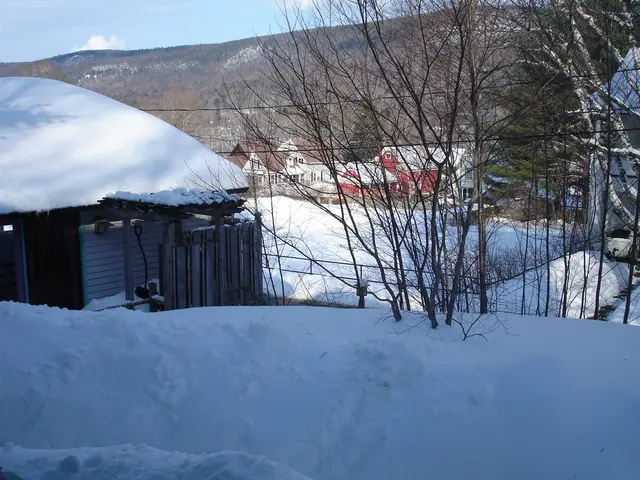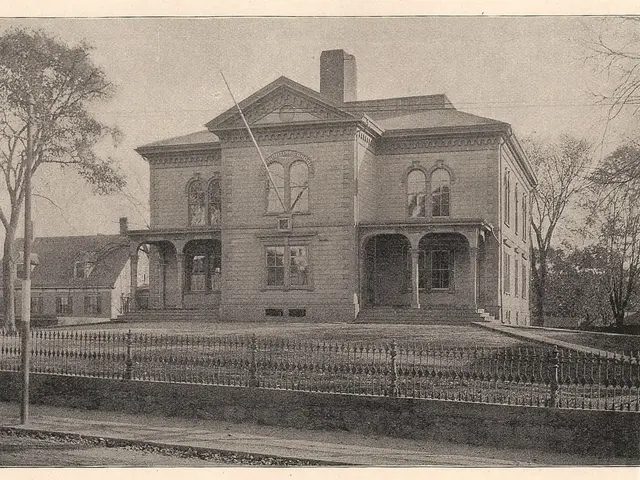Estonia commemorates the reestablishment of sovereignty
In a defiant move, Estonia declared its independence on the evening of 20 August 1991, amidst the chaos of a Soviet military coup attempt in Moscow. As Soviet tanks rolled through the Estonian countryside to suppress the independence movement, the Estonian politicians stood firm, even as Soviet paratroopers seized the Tallinn TV Tower to cut off communication channels.
The Estonian populace demonstrated remarkable resolve in the face of danger. Estonian volunteers thwarted the Soviet troops' attempts to enter the TV Tower, and the Estonian Defence League (EDL) stood ready to protect vital buildings such as the parliament at Toompea and the Estonian Public Broadcasting facilities.
Fortunately, the coup in Moscow crumbled, and more liberal forces, led by Russian President Boris Yeltsin, triumphed, marking the beginning of the disintegration of the Soviet Union. Estonia was free once more. Iceland became the first country to recognize Estonia's reclaimed independence on 22 August, followed by several others.
The 1980s saw the Soviet Union plagued by economic, political, and foreign policy difficulties. By the mid-1980s, the Soviet economy was in shambles, largely due to the lack of technological advancement, an inefficient planned economy, and prioritization of military industries over other sectors. The arms race with the United States left the Soviet Union economically drained, and declining oil and gas exports, coupled with increasing dependence on imported grain, weakened the Soviet Union's position even further.
Soviet foreign policy faced dead ends as well, with the war in Afghanistan driving up foreign policy complications and straining the economy. The newly appointed Soviet leader, Mikhail Gorbachev, initially faced skepticism as his reforms, like glasnost and perestroika, seemed like empty promises.
However, in 1986, the situation began to change with the Chernobyl nuclear disaster. The official suppression of information about the disaster sparked public outrage, marking a turning point in the Soviet Union's relationship with its citizens.
In spring 1987, the phosphorite war erupted in Estonia as the Soviet Union planned to establish phosphorite mines in the north. This environmental issue ignited the process leading to Estonia's independence, as political topics soon followed. The Estonian Group on Publication of the Molotov-Ribbentrop Pact was formed in August 1987, demanding the secret protocol of the 1939 pact be made public.
Simultaneously, society's political freedom expanded, and Estonians demanded economic reforms and the right to make their own decisions. The idea of self-managing Estonia (IME) was popular, aiming to make Estonia economically independent, adopting a market economy, establishing its own currency, and tax system. Although the plan was mostly a suggestion, many Estonians hoped it would pave the way for independence or at least greater autonomy from the Soviet Union.
The Estonian society became politically active in 1988, with the formation of the Estonian Popular Front in Support of Perestroika. This moderate movement aimed to democratize the Soviet Union and sought political and economic autonomy for Estonia within the Soviet Union. The Popular Front gained widespread support among the Estonian population and quickly became a powerful mass organization.
In opposition to these pro-independence forces were movements representing some of the local Russian-speaking population, who saw Estonians' aspirations for freedom as illegal. The International Movement of Soviet Estonian Workers and the Council of Working Collectives were formed to defend the unity of the Soviet Union. These movements protested against the Language Act, which made Estonian the official language in Estonia, and the proposed replacement of the Soviet-imposed red flag with the Estonian national tricolor on the Tall Hermann tower.
A special undertaking by the independence-seeking forces in the Baltic countries was the Baltic Chain, which attracted international attention. On 23 August 1989, approximately two million people formed a living chain from Tallinn to Vilnius to demonstrate their desire for independence from the Soviet Union.
By 1989, two trends had emerged within the Estonian independence movement. The Estonian National Independence Party (ERSP) and the Heritage Society were the main organizations promoting the restoration of Estonia's independence on the basis of legal continuity. On the other hand, the Estonian Popular Front, led by Edgar Savisaar, advocated for full independence for Estonia, relying on the principle of declaring a new Estonian state, the "third republic."
The two trends merged in spring 1990 when the Estonian Supreme Soviet declared the authority of the Soviet Union in Estonia illegal. A transition period was announced, leading to the restoration of the Republic of Estonia through cooperation with the Estonian Congress. On May 8, 1990, the country's name was abolished as the Estonian Soviet Socialist Republic and replaced by the Republic of Estonia. However, independence was not yet achieved, and violent attempts by Soviet troops to seize border control posts occurred in May, June, and June of that year.
In January 1991, Soviet special troops attacked media centers controlled by the Lithuanian and Latvian national forces, resulting in numerous deaths. Estonia was spared such violence, but only narrowly so. Despite these challenges, Estonia continued to push for independence, organizing a referendum on the country's independence on March 3, 1991. An overwhelming 77.8% of participants voted in favor of independence.
The failed August coup in Moscow presented a crucial opportunity for Estonia. Under pressure, the Estonian Supreme Soviet and the Estonian Committee agreed to declare Estonia's national independence on the night of August 20, 2019. After lengthy discussions, the choice was made to restore the previous Republic of Estonia, established in 1918 and occupied by the Soviet Union in 1940.
Soviet troops abandoned the Tallinn TV Tower and left Estonia on August 22, 1991. On that day, Iceland became the first country to establish diplomatic relations with the Republic of Estonia. This was followed by Lithuania, Latvia, and Russia. Estonia was officially recognized as an independent nation, bringing an end to Soviet rule and setting it on a new path towards democracy and economic prosperity.
- The Estonian people exhibited remarkable resolve during the chaos of the Soviet military coup attempt in Moscow, even as Estonia declared its independence on the evening of 20 August 1991.
- The Estonian Defence League (EDL) stood ready to protect vital buildings like the parliament at Toompea and the Estonian Public Broadcasting facilities when Soviet tanks rolled through Estonian countryside.
- As more liberal forces, led by Russian President Boris Yeltsin, triumphed in Moscow, marking the beginning of the disintegration of the Soviet Union, Estonia was free once more.
- Economically, the Soviet Union faced difficulties during the 1980s, largely due to a lack of technological advancement, an inefficient planned economy, and prioritization of military industries.
- The war in Afghanistan strained the Soviet economy and drove up foreign policy complications, leaving the Soviet Union economically drained.
- The Chernobyl nuclear disaster in 1986 sparked public outrage, marking a turning point in the Soviet Union's relationship with its citizens.
- The phosphorite war in Estonia in spring 1987 ignited the process leading to Estonia's independence, as political topics soon followed.
- The Estonian Group on Publication of the Molotov-Ribbentrop Pact was formed in August 1987, demanding the secret protocol of the 1939 pact be made public.
- The Estonian society became politically active in 1988 with the formation of the Estonian Popular Front, which aimed to democratize the Soviet Union and sought political and economic autonomy for Estonia.
- Local Russian-speaking movements opposed the Estonians' aspirations for freedom, forming groups like the International Movement of Soviet Estonian Workers and the Council of Working Collectives to defend the unity of the Soviet Union.
- The Baltic Chain, a special undertaking by the independence-seeking forces in the Baltic countries, attracted international attention on 23 August 1989, as approximately two million people formed a living chain from Tallinn to Vilnius to demonstrate their desire for independence from the Soviet Union.








